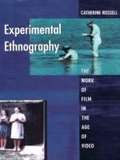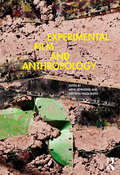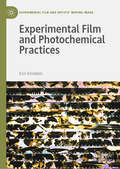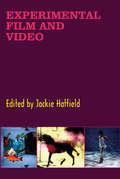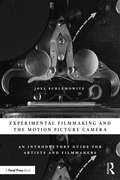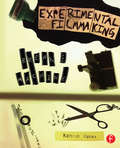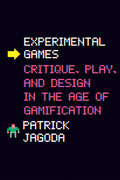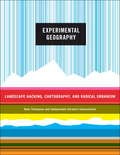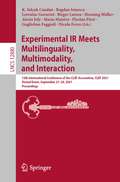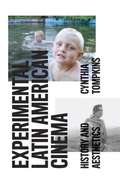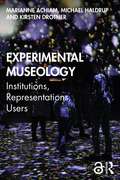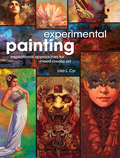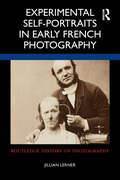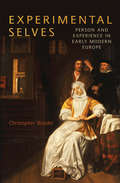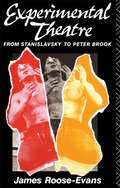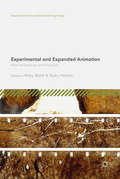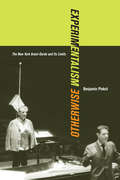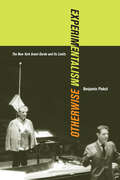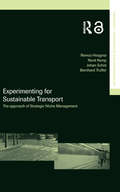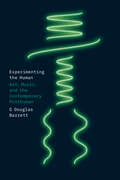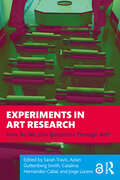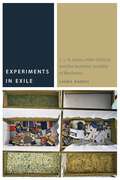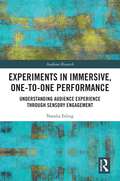- Table View
- List View
Experimental Ethnography: The Work of Film in the Age of Video
by Catherine RussellExperimental film and ethnographic film have long been considered separate, autonomous practices on the margins of mainstream cinema. By exploring the interplay between the two forms, Catherine Russell throws new light on both the avant-garde and visual anthropology. Russell provides detailed analyses of more than thirty-five films and videos from the 1890s to the 1990s and discusses a wide range of film and videomakers, including Georges Méliès, Maya Deren, Peter Kubelka, Ray Birdwhistell, Jean Rouch, Su Friedrich, Bill Viola, Kidlat Tahimik, Margaret Mead, Tracey Moffatt, and Chantal Akerman. Arguing that video enables us to see film differently--not as a vanishing culture but as bodies inscripted in technology, Russell maps the slow fade from modernism to postmodern practices. Combining cultural critique with aesthetic analysis, she explores the dynamics of historical interruption, recovery, and reevaluation. As disciplinary boundaries dissolve, Russell contends, ethnography is a means of renewing the avant-gardism of "experimental" film, of mobilizing its play with language and form for historical ends. "Ethnography" likewise becomes an expansive term in which culture is represented from many different and fragmented perspectives. Original in both its choice of subject and its theoretical and methodologicalapproaches, Experimental Ethnography will appeal to visual anthropologists, as well as film scholars interested in experimental and documentary practices.
Experimental Film and Anthropology (Criminal Practice Ser.)
by Arnd SchneiderExperimental Film and Anthropology urges a new dialogue between two seemingly separate fields. The book explores the practical and theoretical challenges arising from experimental film for anthropology, and vice versa, through a number of contact zones: trance, emotions and the senses, materiality and time, non-narrative content and montage. Experimental film and cinema are understood in this book as broad, inclusive categories covering many technical formats and historical traditions, to investigate the potential for new common practices. An international range of renowned anthropologists, film scholars and experimental film-makers engage in vibrant discussion and offer important new insights for all students and scholars involved in producing their own films. This is indispensable reading for students and scholars in a range of disciplines including anthropology, visual anthropology, visual culture and film and media studies.
Experimental Film and Photochemical Practices (Experimental Film and Artists’ Moving Image)
by Kim KnowlesThis book assesses the contemporary status of photochemical film practice against a backdrop of technological transition and obsolescence. It argues for the continued relevance of material engagement for opening up alternative ways of seeing and sensing the world. Questioning narratives of replacement and notions of fetishism and nostalgia, the book sketches out the contours of a photochemical renaissance driven by collective passion, creative resistance and artistic reinvention. Celluloid processes continue to play a key role in the evolution of experimental film aesthetics and this book takes a personal journey into the work of several key contemporary film artists. It provides fresh insight into the communities and infrastructures that sustain this vibrant field and mobilises a wide range of theoretical perspectives drawn from media archaeology, new materialism, ecocriticism and social ecology.
Experimental Film and Video
by Stephen Littman Jackie HatfieldThe past 40 years of technological innovation have significantly altered the materials of production and revolutionized the possibilities for experiment and exhibition. Not since the invention of film has there been such a critical period of major change in the imaging technologies accessible to artists. Bringing together key artists in film, video, and digital media, the anthology of Experimental Film and Video revisits the divergent philosophical and critical discourses of the 1970s and repositions these debates relative to contemporary practice. Forty artists have contributed images, and 25 artists reflect on the diverse critical agendas, contexts, and communities that have affected their practice across the period from the late 1960s to date. Along with an introduction by Jackie Hatfield and forewords by Sean Cubitt and Al Rees, this illustrated anthology includes interviews and recent essays by filmmakers, video artists, and pioneers of interactive cinema. Experimental Film and Video opens up the conceptual avenues for future practice and related critical writing.
Experimental Filmmaking and the Motion Picture Camera: An Introductory Guide for Artists and Filmmakers
by Joel SchlemowitzExperimental Filmmaking and the Motion Picture Camera is an introductory guide to experimental filmmaking, surveying the practical methods of experimental film production as well as the history, theory, and aesthetics of experimental approaches. Author Joel Schlemowitz explains the basic mechanism of the camera before going on to discuss slow and fast motion filming, single-frame time lapse, the long take, camera movement, workings of the lens, and the use of in-camera effects such as double exposure. A comprehensive guide to using the 16mm Bolex camera is provided. Strategies for making films edited in-camera are covered. A range of equipment beyond the basic non-sync camera is surveyed. The movie diary and film portrait are examined, along with the work of a range of experimental filmmakers including Stan Brakhage, Rudy Burckhardt, Paul Clipson, Christopher Harris, Peter Hutton, Takahiko Iimura, Marie Losier, Rose Lowder, Jonas Mekas, Marie Menken, Margaret Rorison, Guy Sherwin, and Tomonari Nishikawa. This is the ideal book for students interested in experimental and alternative modes of filmmaking. It provides invaluable insight into the history, methods, and concepts inherent to experimental uses of the camera, while providing students with a solid foundation of techniques and practices to foster their development as filmmakers. Supplemental material, including links to films cited in the book, can be found at www.experimentalfilmmaking.com.
Experimental Filmmaking: Break the Machine
by Kathryn RameyExperimental Filmmaking emerges out of a deep and abiding love of celluloid and artisanal media practices and a personal exploration of the field of avant-garde and experimental film, animation and video produced since the beginnings of cinema. Although there have been many critical and historical books on the subject, with the exception of zines and hand-published volumes, there has never been a comprehensive instructional manual on experimental processes. This book will introduce film students and professional filmmakers alike to various methods of experimental animation, film and video production that involve material interventions into the normative process of the medium while offering brief introductions to artists and their works.
Experimental Games: Critique, Play, and Design in the Age of Gamification
by Patrick JagodaIn our unprecedentedly networked world, games have come to occupy an important space in many of our everyday lives. Digital games alone engage an estimated 2.5 billion people worldwide as of 2020, and other forms of gaming, such as board games, role playing, escape rooms, and puzzles, command an ever-expanding audience. At the same time, “gamification”—the application of game mechanics to traditionally nongame spheres, such as personal health and fitness, shopping, habit tracking, and more—has imposed unprecedented levels of competition, repetition, and quantification on daily life. Drawing from his own experience as a game designer, Patrick Jagoda argues that games need not be synonymous with gamification. He studies experimental games that intervene in the neoliberal project from the inside out, examining a broad variety of mainstream and independent games, including StarCraft, Candy Crush Saga, Stardew Valley, Dys4ia, Braid, and Undertale. Beyond a diagnosis of gamification, Jagoda imagines ways that games can be experimental—not only in the sense of problem solving, but also the more nuanced notion of problem making that embraces the complexities of our digital present. The result is a game-changing book on the sociopolitical potential of this form of mass entertainment.
Experimental Geography
by Trevor Paglen Nato Thompson Independent Curators International Jeffrey KastnerA photo of a secret CIA prison. A map designed to help visitors reach Malibu's notoriously inaccessible public beaches. Guidebooks to factories, prisons, and power plants in upstate New York. An artificial reef fabricated from 500 tons of industrial waste. These are some of the more than one hundred projects represented in Experimental Geography, a groundbreakingcollection of visual research and mapmaking from the past ten years.Experimental Geography explores the distinctions between geographical study and artistic experience of the earth, as well as the juncture where the two realms collide (and possibly make a new field altogether). This lavishly illustrated book features more than a dozen maps; artwork by Francis Alÿs, Alex Villar, and Yin Xiuzhen; and recent projects by The Center for Land Use Interpretation, the Raqs Media Collective, and the Center for Urban Pedagogy. The collection is framed by essays by bestselling author Trevor Paglen, Jeffrey Kastner, and editor Nato Thompson.
Experimental IR Meets Multilinguality, Multimodality, and Interaction: 12th International Conference of the CLEF Association, CLEF 2021, Virtual Event, September 21–24, 2021, Proceedings (Lecture Notes in Computer Science #12880)
by Henning Müller Birger Larsen Nicola Ferro Bogdan Ionescu Lorraine Goeuriot Alexis Joly K. Selçuk Candan Maria Maistro Florina Piroi Guglielmo FaggioliThis book constitutes the refereed proceedings of the 12th International Conference of the CLEF Association, CLEF 2021, held virtually in September 2021.The conference has a clear focus on experimental information retrieval with special attention to the challenges of multimodality, multilinguality, and interactive search ranging from unstructured to semi structures and structured data. The 11 full papers presented in this volume were carefully reviewed and selected from 21 submissions. This year, the contributions addressed the following challenges: application of neural methods for entity recognition as well as misinformation detection in the health area, skills extraction in job-match databases, stock market prediction using financial news, and extraction of audio features for podcast retrieval. In addition to this, the volume presents 5 “best of the labs” papers which were reviewed as full paper submissions with the same review criteria. 12 lab overview papers were accepted and represent scientific challenges based on new data sets and real world problems in multimodal and multilingual information access.
Experimental Latin American Cinema: History and Aesthetics
by Cynthia TompkinsWhile there are numerous film studies that focus on one particular grouping of films—by nationality, by era, or by technique—here is the first single volume that incorporates all of the above, offering a broad overview of experimental Latin American film produced over the last twenty years. Analyzing seventeen recent films by eleven different filmmakers from Argentina, Brazil, Cuba, Mexico, Paraguay, and Peru, Cynthia Tompkins uses a comparative approach that finds commonalities among the disparate works in terms of their influences, aesthetics, and techniques. Tompkins introduces each film first in its sociohistorical context before summarizing it and then subverting its canonical interpretation. Pivotal to her close readings of the films and their convergences as a collective cinema is Tompkins’s application of Deleuzian film theory and the concept of the time-image as it pertains to the treatment of time and repetition. Tompkins also explores such topics as the theme of decolonization, the consistent use of montage, paratactically structured narratives, and the fusion of documentary conventions and neorealism with drama. An invaluable contribution to any dialogue on the avant-garde in general and to filmmaking both in and out of Latin America, Experimental Latin American Cinema is also a welcome and insightful addition to Latin American studies as a whole.
Experimental Museology: Institutions, Representations, Users
by Marianne AchiamExperimental Museology scrutinizes innovative endeavours to transform museum interactions with the world. Analysing cutting-edge cases from around the globe, the volume demonstrates how museums can design, apply and assess new modes of audience engagement and participation. Written by an interdisciplinary group of researchers and research-led professionals, the book argues that museum transformations must be focused on conceptualizing and documenting the everyday challenges and choices facing museums, especially in relation to wider social, political and economic ramifications. In order to illuminate the complexity of these challenges, the volume is structured into three related key dimensions of museum practice - namely institutions, representations and users. Each chapter is based on a curatorial design proposed and performed in collaboration between university-based academics and a museum. Taken together, the chapters provide insights into a diversity of geographical contexts, fields and museums, thus building a comprehensive and reflexive repository of design practices and formative experiments that can help strengthen future museum research and design. Experimental Museology will be of great value to academics and students in the fields of museum, gallery and heritage studies, as well as architecture, design, communication and cultural studies. It will also be of interest to museum professionals and anyone else who is interested in learning more about experimentation and design as resources in museums.
Experimental Painting: Inspirational Approaches for Mixed Media Art
by Lisa L. CyrWith page after page of stimulating possibilities, this book guides you on an uncompromising journey to visually dynamic, conceptually provocative, utterly original art. Embrace the spirit of creative play, break out of your comfort zone, and take your art to a whole new level. In her follow-up to the popular Art Revolution, Lisa L. Cyr delves deeper into an inspiring range of two and three-dimensional mixed-media techniques. Discover fresh, alternative ways to apply and manipulate painting media, transform surfaces, and create distinctive, message-driven work. Inside you'll find: A wide array of unconventional tools, materials and processes that help artists blaze their own unique and creative paths 12 step-by-step demonstrations highlighting specific experimental techniques, including freeform painting, making custom tools, and building dimension into a surface with inlaid boxes 3 feature demonstrations showing mixed-media processes at play in the creation of original artworks, from concept to completion A chapter on creative self-promotion revealing the latest marketing and presentation strategies for the working artist
Experimental Self-Portraits in Early French Photography (Routledge History of Photography)
by Jillian LernerThis book explores a range of experimental self-portraits made in France between 1840 and 1870, including remarkable images by Hippolyte Bayard, Nadar, Duchenne de Boulogne, and Countess de Castiglione. Adapting photography for different social purposes, each of these pioneers showcased their own body as a living artifact and iconic attraction. Jillian Lerner considers performative portraits that exhibit uncanny transformations of identity and embodiment. She highlights the tactical importance of photographic demonstrations, promotions, conversations, and the mongrel forms of montage, painted photographs, and captioned specimens. The author shows how photographic practices are mobilized in diverse cultural contexts and enmeshed with the histories of art, science, publicity, urban spectacle, and private life in nineteenth-century France. Tracing calculated and creative approaches to a new medium, this research also contributes to an archaeology of the present. It furnishes a prehistory of the “selfie” and offers historical perspectives on the forces that reshape human perception and social experience. This interdisciplinary study will appeal to readers interested in the history of photography, art, visual culture, and media studies.
Experimental Selves: Person and Experience in Early Modern Europe
by Christopher BraiderDrawing on the generous semantic range the term enjoyed in early modern usage, Experimental Selves argues that ‘person,’ as early moderns understood this concept, was an ‘experimental’ phenomenon—at once a given of experience and the self-conscious arena of that experience. Person so conceived was discovered to be a four-dimensional creature: a composite of mind or 'inner' personality; of the body and outward appearance; of social relationship; and of time. Through a series of case studies keyed to a wide variety of social and cultural contexts, including theatre, the early novel, the art of portraiture, pictorial experiments in vision and perception, theory of knowledge, and the new experimental science of the late-seventeenth and eighteenth centuries, the book examines the manifold shapes person assumed as an expression of the social, natural, and aesthetic ‘experiments’ or experiences to which it found itself subjected as a function of the mere contingent fact of just having them.
Experimental Theatre: From Stanislavsky to Peter Brook
by James Roose-Evans`It is a pleasure to read. Well-written, free of cant, impressively wide-ranging. The book is really an introduction to the avant-garde.' - John Lahr
Experimental and Expanded Animation: New Perspectives and Practices (Experimental Film and Artists’ Moving Image)
by Vicky Smith Nicky HamlynThis book discusses developments and continuities in experimental animation that, since Robert Russet and Cecile Starr’s Experimental Animation: Origins of a New Art (1976), has proliferated in the context of expanded cinema, performance and live ‘making’ and is today exhibited in galleries, public sites and online. With reference to historical, critical, phenomenological and inter-disciplinary approaches, international researchers offer new and diverse methodologies for thinking through these myriad animation practices. This volume addresses fundamental questions of form, such as drawing and the line, but also broadens out to encompass topics such as the inter-medial, post-humanism, the real, fakeness and fabrication, causation, new forms of synthetic space, ecology, critical re-workings of cartoons, and process as narrative. This book will appeal to cross and inter-disciplinary researchers, animation practitioners, scholars, teachers and students from Fine Art, Film and Media Studies, Philosophy and Aesthetics.
Experimentalism Otherwise
by Benjamin PiekutIn Experimental Otherwise, Benjamin Piekut takes the reader into the heart of what we mean by "experimental" in avant-garde music. Focusing on one place and time--New York City, 1964--Piekut examines five disparate events: the New York Philharmonic's disastrous performance of John Cage's Atlas Eclipticalis; Henry Flynt's demonstrations against the downtown avant-garde; Charlotte Moorman's Avant Garde Festival; the founding of the Jazz Composers Guild; and the emergence of Iggy Pop. Drawing together a colorful array of personalities, Piekut argues that each of these examples points to a failure and marks a limit or boundary of canonical experimentalism. What emerges from these marginal moments is an accurate picture of the avant-garde, not as a style or genre, but as a network defined by disagreements, struggles, and exclusions.
Experimentalism Otherwise: The New York Avant-Garde and Its Limits (California Studies in 20th-Century Music)
by Benjamin PiekutIn Experimental Otherwise, Benjamin Piekut takes the reader into the heart of what we mean by "experimental" in avant-garde music. Focusing on one place and time—New York City, 1964—Piekut examines five disparate events: the New York Philharmonic’s disastrous performance of John Cage’s Atlas Eclipticalis; Henry Flynt’s demonstrations against the downtown avant-garde; Charlotte Moorman’s Avant Garde Festival; the founding of the Jazz Composers Guild; and the emergence of Iggy Pop. Drawing together a colorful array of personalities, Piekut argues that each of these examples points to a failure and marks a limit or boundary of canonical experimentalism. What emerges from these marginal moments is an accurate picture of the avant-garde, not as a style or genre, but as a network defined by disagreements, struggles, and exclusions.
Experimenting for Sustainable Transport: The Approach of Strategic Niche Management (Transport, Development and Sustainability Series)
by Johan Schot Remco Hoogma Rene Kemp Bernhard TrufferTechnological change is a central feature of modern societies and a powerful source for social change. There is an urgent task to direct these new technologies towards sustainability, but society lacks perspectives, instruments and policies to accomplish this. There is no blueprint for a sustainable future, and it is necessary to experiment with alternative paths that seem promising. Various new transport technologies promise to bring sustainability benefits. But as this book shows, important lessons are often overlooked because the experiments are not designed to challenge the basic assumptions about established patterns of transport choices. Learning how to organise the process of innovation implementation is essential if the maximum impact is to be achieved - it is here that strategic niche management offers new perspectives. The book uses a series of eight recent experiments with electric vehicles, carsharing schemes, bicycle pools and fleet management to illustrate the means by which technological change must be closely linked to social change if successful implementation is to take place. The basic divide between proponents of technological fixes and those in favour of behavioural change needs to be bridged, perhaps indicating a third way.
Experimenting the Human: Art, Music, and the Contemporary Posthuman
by G Douglas BarrettAn engaging argument about what experimental music can tell us about being human. In Experimenting the Human, G Douglas Barrett argues that experimental music speaks to the contemporary posthuman, a condition in which science and technology decenter human agency amid the uneven temporality of postwar global capitalism. Time moves forward for some during this period, while it seems to stand still or even move backward for others. Some say we’re already posthuman, while others endure the extended consequences of never having been considered fully human in the first place. Experimental music reflects on this state, Barrett contends, through its interdisciplinary involvements in postwar science, technology, and art movements. Rather than pursuing the human's beyond, experimental music addresses the social and technological conditions that support such a pursuit. Barrett locates this tendency of experimentalism throughout its historical entanglements with cybernetics, and in his intimate analysis of Alvin Lucier’s neurofeedback music, Pamela Z’s BodySynth performances, Nam June Paik’s musical robotics, Pauline Oliveros’s experiments with radio astronomy, and work by Laetitia Sonami, Yasunao Tone, and Jerry Hunt. Through a unique meeting of music studies, media theory, and art history, Experimenting the Human provides fresh insights into what it means to be human.
Experimenting the Human: Art, Music, and the Contemporary Posthuman
by G Douglas BarrettAn engaging argument about what experimental music can tell us about being human. In Experimenting the Human, G Douglas Barrett argues that experimental music speaks to the contemporary posthuman, a condition in which science and technology decenter human agency amid the uneven temporality of postwar global capitalism. Time moves forward for some during this period, while it seems to stand still or even move backward for others. Some say we’re already posthuman, while others endure the extended consequences of never having been considered fully human in the first place. Experimental music reflects on this state, Barrett contends, through its interdisciplinary involvements in postwar science, technology, and art movements. Rather than pursuing the human's beyond, experimental music addresses the social and technological conditions that support such a pursuit. Barrett locates this tendency of experimentalism throughout its historical entanglements with cybernetics, and in his intimate analysis of Alvin Lucier’s neurofeedback music, Pamela Z’s BodySynth performances, Nam June Paik’s musical robotics, Pauline Oliveros’s experiments with radio astronomy, and work by Laetitia Sonami, Yasunao Tone, and Jerry Hunt. Through a unique meeting of music studies, media theory, and art history, Experimenting the Human provides fresh insights into what it means to be human.
Experimenting the Human: Art, Music, and the Contemporary Posthuman
by G Douglas BarrettAn engaging argument about what experimental music can tell us about being human. In Experimenting the Human, G Douglas Barrett argues that experimental music speaks to the contemporary posthuman, a condition in which science and technology decenter human agency amid the uneven temporality of postwar global capitalism. Time moves forward for some during this period, while it seems to stand still or even move backward for others. Some say we’re already posthuman, while others endure the extended consequences of never having been considered fully human in the first place. Experimental music reflects on this state, Barrett contends, through its interdisciplinary involvements in postwar science, technology, and art movements. Rather than pursuing the human's beyond, experimental music addresses the social and technological conditions that support such a pursuit. Barrett locates this tendency of experimentalism throughout its historical entanglements with cybernetics, and in his intimate analysis of Alvin Lucier’s neurofeedback music, Pamela Z’s BodySynth performances, Nam June Paik’s musical robotics, Pauline Oliveros’s experiments with radio astronomy, and work by Laetitia Sonami, Yasunao Tone, and Jerry Hunt. Through a unique meeting of music studies, media theory, and art history, Experimenting the Human provides fresh insights into what it means to be human.
Experiments in Art Research: How Do We Live Questions Through Art?
by Sarah Travis Jorge Lucero Azlan Guttenberg Smith Catalina Hernández-CabalExperiments in Art Research: How Do We Live Questions Through Art? is not a conventional research methods guide; it's an encounter for asking questions through art.Originating from the work of a community of tightly connected scholars, artists, and teachers, the book unfolds through a tapestry of moments, practices, and people, embracing the celebration of works in progress and in community. Rooted in the practice of permission-giving, the narrative intertwines personal stories—laying bare the transformative power of unconventional teaching methods, risky endeavors, and the breaking of scholarly norms—and begins by understanding that “art” and “research” are not separate. After that, there are endless directions to take up. Instead of a handbook offering rules or best practices, this text offers an inspiring collection of joy, longing, and determination.This is fascinating reading for arts-based researchers, artists, educators in the arts, education scholars, research-creators, performance theorists, art history scholars, art education scholars, inter- and anti-disciplinary scholars, qualitative and post-qualitative researchers, decolonization scholars, public humanities scholars, and writing pedagogy scholars.
Experiments in Exile: C. L. R. James, Hélio Oiticica, and the Aesthetic Sociality of Blackness (Commonalities)
by Laura HarrisComparing the radical aesthetic and social experiments undertaken by two exile intellectuals, Experiments in Exile charts a desire in their work to formulate alternative theories of citizenship, wherein common reception of popular cultural forms is linked to a potentially expanded, non-exclusive polity. By carefully analyzing the materiality of the multiply-lined, multiply voiced writing of the “undocuments” that record these social experiments and relay their prophetic descriptions of and instructions for the new social worlds they wished to forge and inhabit, however, it argues that their projects ultimately challenge rather than seek to rehabilitate normative conceptions of citizens and polities as well as authors and artworks. James and Oiticica’s experiments recall the insurgent sociality of “the motley crew” historians Peter Linebaugh and Marcus Rediker describe in The Many-Headed Hydra, their study of the trans-Atlantic, cross-gendered, multi-racial working class of the seventeenth and eighteenth centuries. Reading James’s and Oiticica’s projects against the grain of Linebaugh and Rediker’s inability to find evidence of that sociality’s persistence or futurity, it shows how James and Oiticica gravitate toward and seek to relay the ongoing renewal of dissident, dissonant social forms, which are for them always also aesthetic forms, in the barrack-yards of Port-of-Spain and the favelas of Rio de Janeiro, the assembly lines of Detroit and the streets of the New York. The formal openness and performative multiplicity that manifests itself at the place where writing and organizing converge invokes that sociality and provokes its ongoing re-invention. Their writing extends a radical, collective Afro-diasporic intellectuality, an aesthetic sociality of blackness, where blackness is understood not as the eclipse, but the ongoing transformative conservation of the motley crew’s multi-raciality. Blackness is further instantiated in the interracial and queer sexual relations, and in a new sexual metaphorics of production and reproduction, whose disruption and reconfiguration of gender structures the collaborations from which James’s and Oiticica’s undocuments emerge, orienting them towards new forms of social, aesthetic and intellectual life.
Experiments in Immersive, One-to-One Performance: Understanding Audience Experience through Sensory Engagement (Audience Research)
by Natalia EslingThis book investigates audience experience through the lens of sensory engagement in immersive, one-to-one performance. It presents a distinct, practice-based research (PBR) framework – a performance research ‘laboratory’ – designed to evaluate the effects on diverse audience experiences of two ‘sense-specific manipulations’: eye masks and touch. Through a qualitative analysis of responses from seventy-four individual audience participants, this book offers insight into how these popular ‘immersing’ strategies might be experienced. What do these strategies achieve? How do audience participants make sense of them? Do audience responses align with artistic intentions? And how does the PBR framework designed to address these questions influence the outcomes? Through an analysis of three sets of one-to-one performance experiments generating comparative data about the experience of sense-specific manipulation, this book proposes the utility of merging methodologies in artistic research with empirical audience research in theatre and performance studies. This study offers a new perspective on the value of sensory-focused, immersive, one-to-one experience as a means of resensitizing audience participants through performance.
